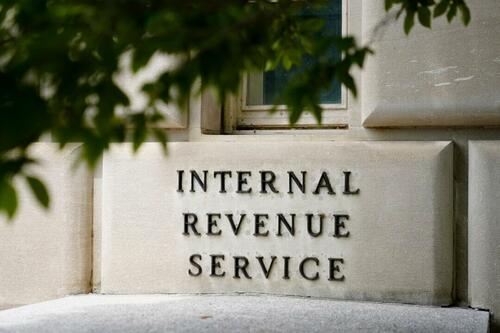Biden Admin Tax Policy Proposals Hurt US Competitiveness
Authored by Michael Wilkerson via The Epoch Times,
Usually when someone starts to talk about taxes, the eyelids grow heavy and the attention wanes, so I’ll keep this short. The Biden administration’s tax policy proposals are a disaster for U.S. competitiveness, for families, and the employers who hire them.
While the Biden administration’s tax proposals have often been vague, with details missing, a few key elements are consistent. They rely on increased tax rates on businesses and individuals, and assume that both can be further burdened without damaging the economy. This is a falsehood.
The Biden administration’s tax proposals have been unrealistic and completely disconnected from the massive growth in expenditure reflected in the administration’s various initiatives, such as the $1.7 trillion Build Back Better plan. The administration claimed that the Build Back Better program would be “fully paid for by the tax proposals,” which was clearly untrue even at first glance. Detailed analysis from the University of Pennsylvania’s Wharton School indicated that the tax proposals would fall short of the administration’s spending plan by nearly $500 billion.
More relevant for individuals is what Build Back Better means for personal income tax. According to analysis from the Tax Foundation, the nation’s leading independent tax policy nonprofit, under the Build Back Better framework, the “average top tax rate on personal income would reach 57.4 percent, giving the U.S. the highest rate in the Organisation for Economic Co-operation and Development (OECD). All 50 states plus the District of Columbia would have top tax rates on personal income exceeding 50 percent.” Under the administration’s plan, the top statutory income tax rate on personal income would be higher than Japan, France, Denmark, Sweden, and each and every one of the 36 OECD nations. State taxes would fall on top of this.
For example, a top earning tax resident of New York or California would face a marginal tax rate of 66.2 percent and 64.7 percent, respectively.
For places like Texas or Florida without state income taxes, the top rate would nonetheless be 51.4 percent.
What will happen to incentives when somewhere between half and two-thirds of income is paid over to the government to pursue policies and programs that most Americans do not support? The effect is predictable. As envisioned, the administration’s proposed tax policies would hinder U.S. competitiveness and reduce incentives to work, save, invest, and innovate.
More recent budget proposals have fared no better. For example, the Biden administration’s 2024 budget proposals would, according to analysis from the Tax Foundation, add up to “$4.8 trillion in new taxes targeted at businesses and high-income individuals.” The budget was projected to reduce long-term GDP and wages by 1.3 percent and 1.0 percent, respectively, while costing 335,000 jobs.
The CHIPS and Science Act of 2022 was intended to counterbalance China and strengthen the U.S. semiconductor manufacturing sector. The objective was to encourage capital investment in American companies, but requires firms that receive funding under the program share “excess profits,” without clearly defining what that means, with the federal government. This uncertainty is an arbitrary and undefined hidden tax that, rather than strengthening competition and encouraging innovation, will have the opposite effect. It will scare away private sources of funding which will not want to risk invested capital only to see the value created expropriated by the government.
A sound tax policy has been a mainstay of conservative politics in the United States for generations. Especially since the Reagan administration, the Republican Party has made moderate tax rates a core policy focus. Before the Reagan administration, the maximum federal income tax rate ranged between 60–70 percent throughout most of the postwar era, and as high as 90 percent during the FDR years. President Reagan launched a new era focused on lower taxes as a stimulant for innovation, investment, and growth. The model worked.
Until the Biden administration, the tax policies and top rates of post-Reagan presidencies of both parties maintained some reasonableness. While Democrats tended toward higher rates and the Republicans somewhat lower, neither sought to move the maximum rate much above 40 percent. And, before President Biden, neither seriously considered imposing an annual wealth tax, a coercive tool used by only a handful of nations around the world. Wealth taxes have been pursued by socialist and communist regimes which sought extreme measures to level wealth inequities in society, but they backfire through widespread manipulations including asset hiding and expatriation. The United States already has an inheritance tax, which is a one-time equivalent tax on estates payable at time of death, and a dozen or so states have similar estate taxes. These are exploitative and punitive against people who are land or asset rich, but cash poor, like many of our farming families in rural America.
There is a direct link between taxation and inequality. The current U.S. tax code benefits the wealthy, whose primary source of income is capital gains, at the expense of the working and middle classes, whose primary source of gain is ordinary income from their hard work. Fundamentally, if taxes on capital (e.g., dividends, interest, carried interest in private equity) are lower than taxes on labor, inequality will continue to rise. This will, over time, lead to increased social unrest, instability and reduced competitiveness.
Tyler Durden
Wed, 02/28/2024 – 19:40
via ZeroHedge News https://ift.tt/Yeqwd6l Tyler Durden
